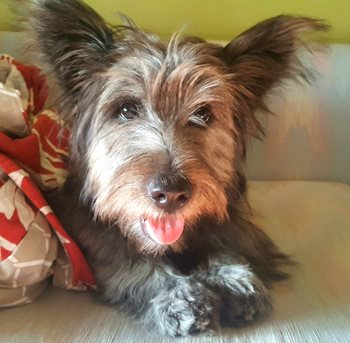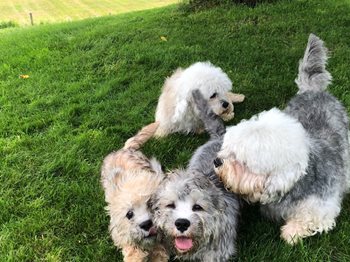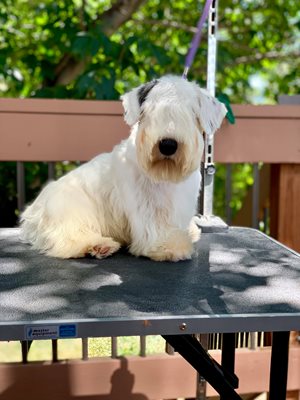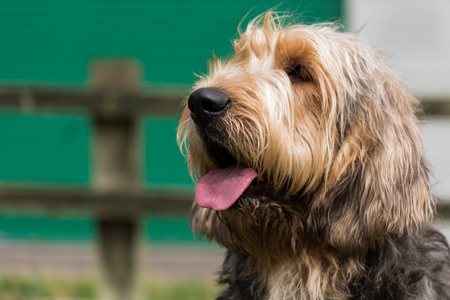
We first met Ian Lynch years ago at the Westminster Kennel Club Dog Show, he, our social media counterpart for the Canadian Kennel Club. We recall his enthusiasm for the dogs (read: the writer, producer and actor was “gaga” over all the breeds), and if memory serves, he especially wanted to lay eyes on a Bedlington Terrier. He got his wish.

Ian with his dogs
These days, the television and radio personality has added “blogger for the Canadian Kennel Club” to his resume. We tend to run into Ian only at major American shows – which means it’s not nearly often enough – but when we learned that he’d recently gotten a new dog, and a vulnerable breed, at that, we were tickled. Our delight at his new choice of breed was doubled when we learned that he also wrote a piece for the Canadian Kennel Club about the experience which he has graciously allowed us to share here:
Going Rare: The Joys of Owning a Vulnerable Breed
October 01, 2019

Dandie Dinmont Terriers by Ian Lynch
With so many of us going back to our roots in various areas of our lives, it is worth remarking that we should also renew our interest in rarer breeds that once enjoyed popularity in days gone by. Dr. Richard Meen said “Purebred dogs are the only living museum of mankind’s journey on Earth”. Sadly, some breeds can no longer tell us how they helped humans with a variety of jobs in the past, as dozens of Canadian Kennel Club recognized breeds are in a vulnerable state and could eventually face extinction if we don’t act to protect them.

Sealyham Terrier photo by Ro Montoya
Cut to me as an adult living in Toronto with a Standard Poodle. Measha was 5 when I started seriously considering getting a second dog. I have always loved and will always love Poodles, but also felt drawn to the Hounds and the Terriers. I was assisting a Canine Good Neighbour Testing at Woofstock in 2016 when our booth was located serendipitously next to the Dandie Dinmont Terrier Club of Canada’s booth. I had always loved the unique look of a Dandie, and apart from seeing one on the street ten years prior, had never gotten a chance to interact with one, much less several as I did that day.
Throughout the next three years, I kept in touch with that breeder. I attended Scottish breeds festivals, Dandie Cuddling Parlours at the Canadian Pet Expo and their specialty show at Paws Way. Earlier this year, the timing worked out and the right puppy was available for me. I became a Dandie owner, member of the breed club and full time spokesperson for anyone who wants to hear about the breed.
Why so rare?
Every endangered breed has its own reasons for the decline in their popularity. Often it has to do with the purpose for which the breed was created. When that job is no longer needed, the number for the breed go down.
Take for example the Otterhound. As their name suggests, this member of the Hound Group’s purpose was hunting otters, which used to be popular in England. Otterhounds were bred to be able to follow otters in the rivers, their durable, water repelling coats and webbed feet made this task possible. Otterhounds were already rare, as hunt masters kept the dogs exclusively for themselves until otter hunting was banned in 1978. With the main purpose of this breed outlawed, hunt masters scattered their packs, allowing private owners to purchase the dogs and introduce them into their own families as pets. A few were brought over to North America during this time, and only a few of these dogs are bred. It’s estimated that there are only about four to seven Otterhound litters in North America a year.

Sometimes a breed’s decline happens when attention is turned towards another breed. The American Water Spaniel was developed and primarily kept in the Great Lakes region of the United States as a hunting assistant that could retrieve on land and in water. They were favoured waterfowl hunters because the American Water Spaniel is small enough to ride in a boat, but is strong enough to bring back a duck or goose. The breed’s numbers started to go down at the beginning of the 20th century, because hunting had become a less common activity, and larger retriever breeds became more popular.
Buying a Rare Breed
It’s a fact that many of our beloved purebred dogs are facing extinction. There are more Giant Pandas in the world than there are Skye Terriers. If you feel called to help out a struggling breed by owning one, loving one and telling your circle and all who you meet about them, then you are a conservationist in my eyes.
Getting in touch with breeders is now easier than ever thanks to the internet and resources like the Canadian Kennel Club’s Puppy List (www.thepuppylist.ca). Searching for a breed club online or checking out a club’s Facebook page is another way to connect with breeders. Once the breeder decides that you would be a good fit as an owner of their breed, you may be put on a wait list as there might not be any puppies currently available. Generally a breeder will keep you up to date on planned breeding and with a bit of luck and patience, the day will come where you get to take your puppy home.
Becoming an Ambassador
Owning a vulnerable breed means you’ll be talking a lot. To people you know, to strangers, to curious neighbours who want to know “what is it?” I get hilarious guesses as to what my Dandie is (“Irish Wolfhound Basset Hound cross?”) and if my neighbour got a quarter for every time someone called his German Pinscher a “baby Doberman”, he would be a very rich man.
The owner of a rare breed has a responsibility to inform anyone who is interested about their breed. My Dandie Leroy even has business cards. I’m serious. My dog’s breeder handed me a stack when I bought him and initially thought it was delightfully ridiculous, however, they have come in so handy that I asked for more when I was recently visiting her! The card has an image of the breed, description and a link to the breed club’s homepage. I would recommend cards for all owners of rare breeds. It always gets a laugh when I hand them out, but if it gets people interested in learning more about Dandies, I am happy to do it.
Fun at Shows
Those looking to take home a win at conformation shows will enjoy competing with a less popular breed. Breeder, writer and judge Allan Reznik explains the appeal of entering the ring with a rare breed “Exhibitors, especially owner-handlers, can have a tough time of it showing a popular breed, or one in which the vast majority of winners are shown by professional handlers. For them, the thought of showing the only entry in the breed and automatically getting into the Group every day can be incredibly exciting. If this is your goal, and you are getting discouraged competing at the breed level, consider a minority breed. You get more time in the ring while helping to give an uncommon breed visibility. That’s win-win in my book.” In mine as well.
Many wonderful dogs are disappearing at an alarming rate. Owning, loving and promoting an endangered breed are major ways you can help prevent the extinction of a major piece of history.
Work Cited
Ripley, Katherine, akc.org. American Kennel Club. 18 May 2016.
Reznik, Allan, akc.org. American Kennel Club. 12 April 2019.
Bchighlandgames.com. BC Highland Games and Scottish Festival. n.d.
Szeremy, Susi, Nationalpurebreddogday.com. National Purebred Dog Day.
The Rare Otterhound. WordPress.com. n.p. n.d.
The opinions expressed by authors on the Canadian Kennel Club Blog and those providing comments are theirs alone, and do not reflect the opinions of the Canadian Kennel Club or any of its employees.
Image: Skye Terrier Photo by Cynthia Crysdale

Thank you Ian! I also have a breed that is dangerously dwindling in numbers. Once they are gone, we will not be able to bring these breeds back.
Thank you for writing, Diane. Would you mind sharing a photo of your vulnerable breed so that other readers can see what we stand to lose?
Thank you for a wonderful article. We recently became the proud owners of a purebred Otterhound after many years of research. We couldn’t be happier! We want to be great ambassadors of the breed and hope to educate people on the joys of a purebred dog!!
Thank you for the kind words, Debbie, and congratulations on your new dog. He has an absolutely wonderful face, and we have no doubt that as delighted as you are with the little fella, you’ll be marvelous ambassadors!
Wonderful article. I love the quote “purebred dogs are the only living museum of mankind’s journey on Earth” which expresses something I try to tell people but ever so much more gracefully and succinctly.
PS. I’m on a waiting list for a Dandie, to go along with my Sealyham. Maybe a Skye after that 🙂
We love that quote too, We have been saying for a long time that purebred dogs are museum pieces with a pulse, and hadn’t been aware of that other, marvelous quote. Good luck with your future Dandie, it’s a splendid breed!
Owner of a Sussex Spaniel here. Great article! You definitely become an ambassador when you have a rare breed. I get asked a lot about my dog but I love the breed so I don’t mind chatting about them.
This is my Sussex Spaniel Luna
Marvelous comment, Elisabeth. It’s why we created the “Ask About My Heritage” bandana for sale in our shop. Even the shyest rare breed owner will find themselves engaged in conversation with a stranger when they’re asked, “Ok, so tell us about your dog’s heritage!”
I fondly remember Stump, who won at Westminster years ago…while my breeds are Poodles and Chessies, these little brownies will always find their way into a heart!
As an owner of Irish Water Spaniels, I am also a supporter of rare and endangered breeds. Given the influence on Golden Retrievers and American Water Spaniels to name 2 my breed was quite influential. I participate in many events to help showcase this amazing breed of dog.
Love hearing this, Lisa, and love the picture!
I am an owner of a rare breed dog, a Sealyham terrier, which I imported to Poland from Hungary having read about that interesting, funny breed in Konrad Lorenz’s book ” Man Meets Dog”. It was not available here three years ago, but I have heard of a few dogs imported from the East and the South of Europe recently and two litters born within the last two years so maybe something will change for better.
We are delighted to hear your news, Anna, and greatly appreciate your sharing it with us (along with the photograph). Most assuredly, we hope the trend towards increased numbers will continue!
I am the proud “pawrent” of a Cardigan Welsh Corgi, which is dwindling in numbers in their native UK, but is not exactly on the endangered breed list. As I have repeated ad nausem in the four months since we brought her home, “No, she’s not an Aussie-Corgi mix. She’s the type of Corgi nobody knows about.” Her best friends are a brother-sister duo of an adorable Sealyham and white Scottish Terrier. All three pups are amazing breed ambassadors! 🙂 Thank you so much for recognizing the importance of not allowing the most vulnerable of dog breeds to fall to history!
It is our absolute pleasure – and moral obligation, we think – to highlight the plight of these marvelous breeds, Becky. We so enjoy their antics, their history, and their contributions to dogdom. Thank you for writing and sharing the photograph of your gang!
There has been some increased interest and growth (I believe) in the Swedish Vallhund. A busy, noisey dog, very smart and great at dog activities such as agility, obedience, barn hunts, herding..easy coat care…still used to move stock..nice size. Super friendly! Breeding is limited and very selective to maintain health of the breed.
I am owned by a loving, silly, fun, beautiful 2 year old Dandie Dinmont Terrier. She is the proud mama of 5, 3 week old boys right now.
I have never had the privilege of being loved by any dog like a Dandie. She loves everyone but loves kids with all her heart and soul!